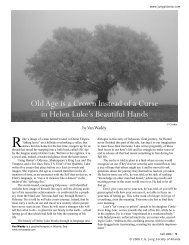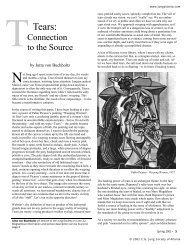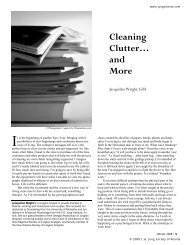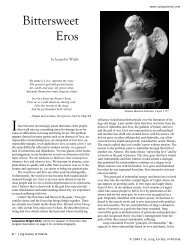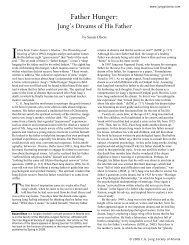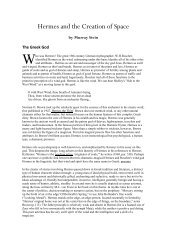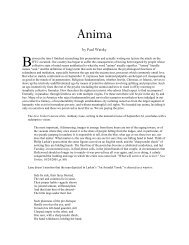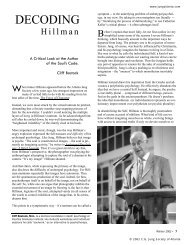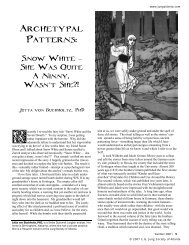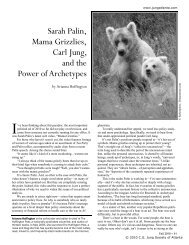Christ, a Symbol of the Self - C.G. Jung Society of Atlanta
Christ, a Symbol of the Self - C.G. Jung Society of Atlanta
Christ, a Symbol of the Self - C.G. Jung Society of Atlanta
You also want an ePaper? Increase the reach of your titles
YUMPU automatically turns print PDFs into web optimized ePapers that Google loves.
Risen <strong>Christ</strong> as symbol <strong>of</strong> <strong>the</strong> filius philosophorum<br />
Final Emblem <strong>of</strong> <strong>the</strong> Rosarium Philosophorum, 1550<br />
There are multiple implications <strong>of</strong> preserving <strong>the</strong> distinction<br />
between <strong>the</strong> historical Jesus and <strong>the</strong> archetypal/symbolic<br />
<strong>Christ</strong>, both for individuals and religious institutions and<br />
groups. For <strong>the</strong> individual, <strong>the</strong> archetypal <strong>Christ</strong> is not limited<br />
to one man, Jesus, but can be seen as <strong>the</strong> potential “greater<br />
personality” in every individual. Understood psychologically,<br />
<strong>the</strong> life <strong>of</strong> <strong>Christ</strong> represents <strong>the</strong> various phases and expressions<br />
<strong>of</strong> <strong>the</strong> <strong>Self</strong> as it undergoes incarnation in an individual ego, that<br />
is, <strong>the</strong> various stages <strong>of</strong> <strong>the</strong> process <strong>of</strong> individuation.<br />
<strong>Jung</strong> speaks to <strong>the</strong> necessity <strong>of</strong> withdrawing our projections<br />
from a historical or external <strong>Christ</strong> figure (Jesus, in this case) if<br />
we are to discover experientially <strong>the</strong> “<strong>Christ</strong> within,” or <strong>the</strong><br />
<strong>Self</strong>. He writes, “The <strong>Self</strong> or <strong>Christ</strong> is present in everybody a<br />
priori, but as a rule in an unconscious condition to begin with.<br />
But it is a definite experience <strong>of</strong> later life, when this fact becomes<br />
conscious…It is only real when it happens, and it can<br />
happen only when you withdraw your projections from an outward<br />
historical or metaphysical <strong>Christ</strong> and thus wake up <strong>Christ</strong><br />
within.” (CW:18:par.1638) If <strong>Christ</strong> remains outside us, ei<strong>the</strong>r<br />
as an example <strong>of</strong> an ideal or as an external object <strong>of</strong> worship<br />
only, <strong>the</strong> deeper levels <strong>of</strong> <strong>the</strong> soul are never engaged. The result<br />
is that religion and religious practice may deteriorate into<br />
adherence to rational dogma and trying to follow a set <strong>of</strong> external<br />
rules.<br />
From this psychological perspective, <strong>the</strong> classical “imitation <strong>of</strong><br />
<strong>Christ</strong>” would not mean that we are to try to “copy” Jesus, but<br />
that we are to live our individual lives as fully, as au<strong>the</strong>ntically,<br />
and as obediently (to a greater Source) as Jesus lived his. Psychologically,<br />
this is <strong>the</strong> individuation process; <strong>the</strong>ologically, it<br />
is <strong>the</strong> process <strong>of</strong> redemption and sanctification.<br />
Applying this perspective to what it might mean to take up<br />
one’s own cross as Jesus invited his followers to do, Edward<br />
Edinger suggests: “To take up one’s own cross would mean to<br />
accept and consciously realize one’s own particular pattern <strong>of</strong><br />
wholeness.” (Edinger, Ego and Archetype, p.135) This invariably<br />
involves being suspended between successive pairs <strong>of</strong><br />
opposites (like a veritable crucifixion), with its attendant suffering,<br />
and repeated death/rebirth experiences <strong>of</strong> <strong>the</strong> ego as it<br />
learns to bow to <strong>the</strong> demands <strong>of</strong> <strong>the</strong> <strong>Self</strong>. However, consciously<br />
“carrying one’s life” in this way also provides <strong>the</strong> possibility<br />
<strong>of</strong> discovering <strong>the</strong> meaning <strong>of</strong> one’s unique, individual<br />
life and participating in life’s larger purposes. It means <strong>the</strong><br />
possibility <strong>of</strong> discovering one’s vocation and one’s own myth,<br />
that story which helps to make meaning out <strong>of</strong> <strong>the</strong> mystery <strong>of</strong><br />
existence.<br />
Differentiating <strong>the</strong> historical Jesus and <strong>the</strong> archetypal Redeemer<br />
(<strong>Christ</strong>) has implications for religious groups and institutions,<br />
as well. With <strong>the</strong> recognition that <strong>the</strong> archetypal Redeemer<br />
has multiple -- perhaps unlimited -- manifestations, <strong>the</strong><br />
<strong>Christ</strong>ian Church, as well as o<strong>the</strong>r religious groups and institutions,<br />
are cautioned against exclusive claims to truth. A literalistic<br />
understanding <strong>of</strong> Jesus (or any o<strong>the</strong>r central religious<br />
figure/leader) leads to lethal divisions through claims that<br />
“God is our God and has no o<strong>the</strong>r children but us,” which<br />
<strong>Jung</strong>ian analyst Murray Stein calls a transference illusion. In<br />
our highly pluralistic society, and a world shrinking every day,<br />
it is imperative that religious people <strong>of</strong> every stripe break<br />
through that illusion and consider that God is not bound to a<br />
particular tribe, nor confined by <strong>the</strong> dogmatic boxes <strong>of</strong> any<br />
religion. The divine Spirit is not a commodity controlled by<br />
religious corporations; instead, as <strong>Jung</strong> poetically writes, “a<br />
living spirit (which) grows and even outgrows its earlier forms<br />
<strong>of</strong> expression…This living spirit is eternally renewed and pursues<br />
its goal in manifold and inconceivable ways throughout<br />
<strong>the</strong> history <strong>of</strong> mankind…<strong>the</strong> names and forms which men have<br />
given it mean very little; <strong>the</strong>y are <strong>the</strong> changing leaves and blossoms<br />
on <strong>the</strong> stem <strong>of</strong> <strong>the</strong> eternal tree.” (CW:11:par.538)<br />
Without a symbolic appreciation <strong>of</strong> <strong>Christ</strong>, or any o<strong>the</strong>r religious<br />
figure or leader, religious concerns are made small by<br />
literalism. This in turn is <strong>the</strong> spawning ground for fundamentalism<br />
which, in spiritual matters, is tantamount to <strong>the</strong> death <strong>of</strong><br />
<strong>the</strong> soul. In addressing <strong>Christ</strong> as a symbol <strong>of</strong> <strong>the</strong> <strong>Self</strong>, <strong>Jung</strong><br />
challenged <strong>the</strong> Church to recover its symbolic life. Failing to<br />
do that, <strong>the</strong> Church will remain a minor voice in speaking to<br />
<strong>the</strong> deep spiritual longings <strong>of</strong> modern men and women. Fur<strong>the</strong>rmore,<br />
it may unwittingly undermine <strong>the</strong> reconciliatory and<br />
peace-making processes it desires to promote in <strong>the</strong> world.<br />
(Author's Postscript: This article was written and submitted<br />
Quarterly News – Fall 2001 page 7<br />
www.jungatlanta.com<br />
© 2001 C.G. <strong>Jung</strong> <strong>Society</strong> <strong>of</strong> <strong>Atlanta</strong>




